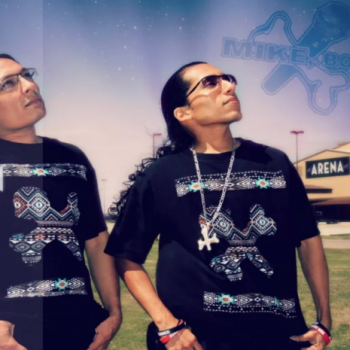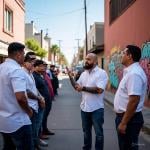I grew up in a mixed Latino culture. The hood was the backbone of my years. Researching how Christian Hip Hop influences multiple cultures, I was drawn to see how the hood, the barrio, uses Christian Hip Hop. The sights and sounds discovered were personally warming, intellectually stimulating, and hit at the core of faith.
There is a firm fellowship that comes through Christian Hip Hop when influenced by Latino/Latine culture. Most may be comfortable with the stereotype of Latino communities following a Catholic discipline. Stepping outside of this pop culture assimilated identity, Christianity is grounded in the Latino/Latine community. When artists embrace the available expression of Hip Hop, there is a fellowship amplified through the core elements of Christian Hip Hop – evangelism, discipleship, gospel-centered lyrics, and testimony.
I elected to provide a critical review of Latino/Latine culture and the use of Christian Hip Hop. This exploration sought to understand how the core elements of Christian Hip Hop are fused within this genre. The artist trope on Hip Hop’s strong global identity and narrates it through a lived barrio experience.
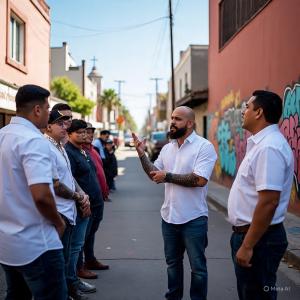
Saving the Barrio Through Christian Hip Hop
Lordside G – God Bless the Barrio, posted June 2012, ThaLordsideGangsta
A testament from a man who has seen hard times. The lyrics say it all. The context does not candy-coat the issue. This work presents the core elements of Christian Hip Hop directly: evangelism, discipleship, scripture-centered lyrics, and testimony.
Opening with a soft acoustic guitar riff, the culture of the street/hood comes through as much as his conviction and faith. Contextualizing Latino signifiers, these elements secure the foundation and focus on community. The heightened reference to testimony is a strong feature of Latino Christian Hip Hop. The next element of focus is on discipleship. This is a narrative witnessed by other Christian Hip Hop artists who may have come from a “jailhouse conversion.” The necessity to express one’s testimony not only serves the community, but it also helps the presenter to remain fixed in their faith. Coupled with discipleship, these two elements prove fundamental to those coming from a gangster culture. The strong emphasis on community (read: the gang) laid the groundwork and ideology of this perspective. Teaching younger gang bangers how to survive in the hood/barrio is transposed as Christian discipleship. Both operate along the same lines, with notable differences of opinion, but the same intent: support and serve the community. Asking for blessings for the barrio is a vocal and visible representation of each of the core elements of Christian Hip Hop.
The inclusion of the barrio context is provided less for the rapper than it is for the viewer. This side steps a voyeur external review of the barrio and places the viewer directly in the living context of the barrio. Such action claims space and place, narrating it through the lyrics and presence of the rapper. Both space and place are explored by the rapper to articulate their conversion from their origins. This gives voice to the location as a supplementary reference to the core elements of Christian Hip Hop. With the narrativity of the rapper, space and place speak to discipleship, evangelism, scripture-centered lyrics (read: text), and testimony. In such a manner, the rapper echoes their faith-based discipline by way of narrating on space and place. These layers firm ones commitment to their faith while evangelising to those viewing the work. Further, this narrativity of space and place through the core elements of Christian Hip Hop amplifies these in a feedback loop from the rapper to the audience. Framing this process is witnessed throughout Hip Hop, signifying and narrating space and place as an extension of a rapper’s identity. Christian Hip Hop artists engage this critical discourse as an opportunity to share their testimony and include the other core elements of Christian Hip Hop. With technology, this operation is not limited to being in person. It can be produced through multiple media channels.
“God Bless the Barrio” illustrates this analysis in a living document, poised with the same intent and power today as when it was first recorded and published.
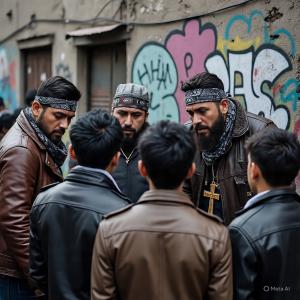
A New Breed Of G
LordSide Gangster – LordSiders, posted October 2009, OfficialChristianTV
Getting past the odd introduction, this work follows the common theme from the artist. Testimony, faith, and conviction are stated and balanced. The environment again is in the barrio/hood. The reality of the experience comes through with no softening.
The tag line, “A New Breed Of A G,” is on the opening screen before the formal video starts. This statement says it all. The work takes advantage of a low-tech image to place an emphasis on the lyrics. There is a strong point in giving oneself to others. Sacrifice is the core point of this work. Scripture that codifies this perspective stated in the work, would be,
“Greater love has no one than this: to lay down one’s life for one’s friends” (John 15:13).
This is how we know what love is: Jesus Christ laid down his life for us, and we ought to lay down our lives for our brothers and sisters” (1 John 3:16).
“But God demonstrates his own love for us in this: While we were still sinners, Christ died for us” (Romans 5:8).
“I have been crucified with Christ and I no longer live, but Christ lives in me. The life I now live in the body, I live by faith in the Son of God, who loved me and gave himself for me” (Galatians 2:20).
The first two scriptures are about our selflessness for another human. The last two scriptures speak to Christ’s sacrifice for us. If the high calling is to live as Christ lived, these last two scriptures point to the intent which the rapper is claiming, in so many words, in the video.
Other related scriptures which outline the same intent,
“And let us consider how we may spur one another on toward love and good deeds, not giving up meeting together, as some are in the habit of doing, but encouraging one another—and all the more as you see the Day approaching” (Hebrews 10:24-25).
“A new commandment I give to you, that you love one another: just as I have loved you, you also are to love one another” (John 13:34).
These scriptures align with the work (read: lyrics) the rapper states. He is not preaching to an invisible mass, but to the viewer and listener. The rapper uses these intentionally to articulate the core elements of Christian Hip Hop.
Sacrifice In The Hood
Lordside Gangsta – Blood In Blood Out, posted April 2011, Thalordsidegangsta.
The opening bilingual dialogue is a refreshing way to set up the work. The following short script pushes the envelope on how to present the gospel to a brother. Having both of these at the start of the track frames the necessity of faith, testimony, and belief coming from a rough barrio/hood. The stereotypes of Mexican gangsta culture are not diminished. The stereotypes are signified to articulate the realities of the barrio/hood experience. It’s not a complex track. The narrative makes the work stand on two firm feet.
The video works on two levels simultaneously. One is the act of violence, taking another’s life as part of the gang culture. The other is an evangelism call recognizing Christ’s sacrifice for us. The reference to John 3:16 is placed close to the middle of the track. Serving to expand the narrative, this scripture quote works against the remaining narrative of the video, which deals with a murder and a call for salvation at the time of death.
The imagery of the tattooing may appear unusual at first. Noting the permanence of tattoos, the involvement here is a metaphor for the permanence of a Life with Christ that is only possible by the blood he shed. We live by taking in His blood through the acts of confession, repentance, and acceptance. Christ shed His blood for us (read: blood out). The tattoo is a reminder of this ongoing logic and reality: Christ died for us, yet while we were sinners, he gave His life for us so that we may be saved (Romans 5:8).
The double entendre of blood being taken in while also being shed is a fundamental principle of Christianity; the substitution of Christ’s life for ours. The Old Testament covenant was founded on the sacrifice of a lamb, the blood of the lamb shed for our salvation. The New Testament is the sacrifice that Christ did for us, the shedding of His blood, the blood of a new lamb, giving His life, shedding His blood for our salvation. “Blood in, blood out,” then, as a title, is a summary of the gospels and the contexts of the Bible itself. The images and lyrics function to support this point while evangelising to the viewer, to whom the rapper gestures throughout.
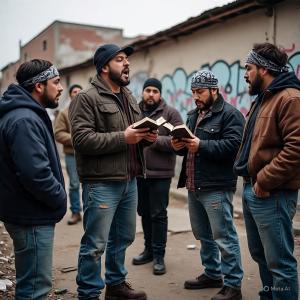
Is The Barrio Saved?
These artists provide a behind-the-scenes look at living and testifying in the hood/barrio. A surface review would easily dismiss these works as following a Mexican gangster culture. The deeper the lyrics are reviewed, it is realized that the surface is the vehicle to disseminate the core elements of Christian Hip Hop. Utilizing the environment as an advantage, the rappers communicate across borders with the leverage of the surface representation. The sounding context signifies a Latino sound at the intersection of Hip Hop. This relationship further articulates a vehicle of expression and communication to the hood/barrio. These works embrace the rough, unbridled, stereotyped presence of Latine gangster culture. This provides an acculturated voice for evangelism, discipleship, gospel-centered lyrics, and testimony – the core elements of Christian Hip Hop.
The question presented was, “Is the barrio saved?” Following these artists, it is clear that their mission field is the barrio, the streets, the hood. The rhetorical nature of the question is addressed through the involvement of these sounds and lived Christian Hip Hop experiences. Capitalizing on the energy and power of Christian Hip Hop, these artists evoke the fluidity that Christian Hip Hop provides to a community, in this case, the barrio. The barrio will continue to be “saved” through the ongoing creation of Christian Hip Hop, founded on a barrio experience.






